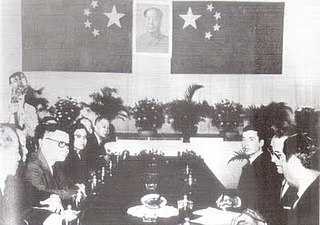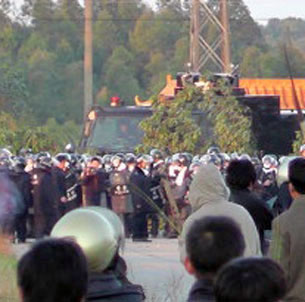Related Research Articles

Zhongshan is a prefecture-level city in the south of the Pearl River Delta in Guangdong province, China. As of the 2020 census, the whole city with 4,418,060 inhabitants is now part of the Guangzhou–Shenzhen conurbation with 65,565,622 inhabitants. The city-core subdistricts used to be called Shiqi or Shekki.

Lufeng, alternately romanized as Lukfung in Cantonese, is a county-level city in the southeast of Guangdong province, administered as a part of the prefecture-level city of Shanwei. It lies on the mainland on coast of the South China Sea east of Hong Kong.

Shanwei, or Swabue, or also commonly known as Hailufeng is a prefecture-level city in eastern Guangdong province, People's Republic of China. It borders Jieyang to the east, Meizhou and Heyuan to the north, Huizhou to the west, and looks out to the South China Sea to the south. It lies approximately 120 kilometres (75 mi) east of Shenzhen and the locals speak the Haifeng dialect.
The Tompkins Square Park riot occurred on August 6–7, 1988 in Tompkins Square Park, located in the East Village and Alphabet City neighborhoods of Manhattan, New York City. Groups of "drug pushers, homeless people and young people known as squatters and punks," had largely taken over the park. The East Village and Alphabet City communities were divided about what, if anything, should be done about it. The local governing body, Manhattan Community Board 3, recommended, and the New York City Parks Department adopted a 1 a.m. curfew for the previously 24-hour park, in an attempt to bring it under control. On July 31, a protest rally against the curfew saw several clashes between protesters and police.
The Dongzhou protests refers to a series of protests that took place for seven months until December 2005 in Dongzhou (东洲), a subdistrict in Shanwei prefecture, Guangdong Province, China. The protests were organized in opposition to government plans to partially infill the bay and build a new power plant. It resulted in the shooting deaths of several residents in the night of 6 December 2005 by People's Armed Police. The death toll is unknown, with different sources mentioning anywhere from three to several dozen deaths. The protests resumed in November 2006.

The 12-3 incident was a series of political demonstrations and riots against Portuguese colonial rule in Macau which occurred on December 3, 1966. The incident, inspired by the Cultural Revolution in the People's Republic of China, occurred as a direct response to a violent police crackdown by colonial authorities against local Chinese protesters demonstrating against corruption and colonialism in Macau.

Mischief Reef, also known as Panganiban Reef, is a low tide elevation (LTE) reef/atoll surrounding a large lagoon in the SE of Dangerous Ground in the east of the Spratly Islands in the South China Sea. It is located 250 kilometres (130 nmi) west of Palawan Island of the Philippines. Administratively, it belonged to the Kalayaan Islands municipality of the province of Palawan. It is also under the de facto jurisdiction of Nansha islands, Sansha City, Hainan province, China. Activities by the People's Republic of China (PRC) in the mid-2010s have created a large artificial island on the atoll including an approximately 2,700-metre (8,900 ft) runway and associated airfield.
The 2008 Longnan riot was a protest that turned into a riot involving thousands of people in Longnan, Gansu, People's Republic of China.
A series of violent riots over several days broke out on 5 July 2009 in Ürümqi, the capital city of the Xinjiang Uyghur Autonomous Region (XUAR), in northwestern China. The first day's rioting, which involved at least 1,000 Uyghurs, began as a protest, but escalated into violent attacks that mainly targeted Han people. According to Chinese state media, a total of 197 people died, most of whom were Han people or non-Muslim minorities, with 1,721 others injured and many vehicles and buildings destroyed. Many Uyghurs disappeared during wide-scale police sweeps in the days following the riots; Human Rights Watch (HRW) documented 43 cases and said figures for real disappearances were likely to be much higher.
The Shaoguan incident was a civil disturbance which took place overnight on 25–26 June 2009 in Guangdong, China. A violent dispute erupted between migrant Uyghurs and Han Chinese workers at a toy factory in Shaoguan as a result of false allegations of the sexual assault of a Han Chinese woman. Groups of Han Chinese set upon Uyghur co-workers, leading to at least two Uyghurs being violently killed by angry Han Chinese men, and some 118 people injured, most of them Uyghurs.

Jieshi is a Town in Lufeng, Shanwei Municipality, Guangdong.
The 2011 Yunnan protest occurred from March 25 to March 29, 2011, in Suijiang County, Yunnan, People's Republic of China. This event, formally known as the 2011 Yunnan Protest, occurred as a land dispute after the government seized land which was to be grounds for the development of a new power plant. This event was considered a land protest as the civilians protested in protection of the land they lived and worked on.

The Wukan protests, also known as the siege of Wukan, was an anti-corruption protest that began in September 2011, and escalated in December 2011 with the expulsion of officials by villagers, the siege of the town by police, and subsequent détente in the village of Wukan, in the east of Guangdong province. The villagers rose up again in June 2016, but were again suppressed. The most recent rounds of clashes were in September 2016, when the former village leader Lin Zulian was sentenced to jail. The clashes were suppressed.

The 2011 Haimen protest of December 2011 occurred in the Chinese town of Haimen, Guangdong. The protests, which drew thousands of participants, were met with detentions and tear gassing by authorities.
The Shifang protest was a large-scale environmental protest in the southwestern Chinese city of Shifang, Sichuan province, against a copper plant that residents feared posed environmental and public health risks. The protests spanned July 1-3 2012, and drew thousands of participants. Police were dispatched to break up the demonstrations, and reportedly shot tear gas and stun grenades into the crowd. Chinese authorities said some protesters stormed a government building and smashed vehicles. Images and video of the protest circulated on the microblogs and social networking websites throughout China, some showing the protesters — many of them students — badly beaten. The protests ended late on July 3rd when the local government announced that it had terminated construction of the metals plant, and released all but six protesters who had been taken into custody.

The Letpadaung Copper Mine is a large surface mine in the Salingyi Township of Sagaing Region of Myanmar. Since Myanmar began liberalizing in 2011 the mine has been the site of contentious protest and come to symbolize the shortcomings of political reform. Villagers displaced by the Chinese-operated mine contend that they have not received fair compensation while the company claims that it has been socially responsible throughout the process.

Kenneth Lau Ip-keung is a New Territories rural leader in Hong Kong. He is the current chairman of the Heung Yee Kuk and member of the Legislative Council of Hong Kong for the Heung Yee Kuk functional constituency, succeeding his father Lau Wong-fat in 2015 and 2016 respectively. He has been an unofficial member of the Executive Council of Hong Kong since 2017. He was awarded the Bronze Bauhinia Star by the Hong Kong SAR Government in 2017.

Thirty-eight Vietnamese police officers were taken hostage by villagers in Đồng Tâm commune, Mỹ Đức district, Hanoi on April 15, 2017, after police arrested four villagers without a warrant in a land dispute. The hostages included district People's Committee deputy chief Đặng Văn Triều, Deputy Chief of Public Security Nguyễn Thanh Tùng, district party committee propaganda chief Đặng Văn Cảnh, and two journalists. Two days after the initial hostage-taking, three detainees were released by the police in Hanoi; one was the main representative of the people in the land dispute, Lê Đình Kình, an 82-year-old man who was injured and hospitalized. In response, the villagers released 15 policemen; three more escaped.
The 2012 Zhongshan riot occurred on and following June 25, 2012 in the Shaxi district of Zhongshan, in China's Guangdong province. Sparked by a fight between a migrant teen from Sichuan and a local schoolboy, the violence snowballed into a major riot by hundreds of mostly Sichuanese workers as tensions between migrant workers and natives boiled over.
The 2005 Huashui protest took place in Huashui (画水) Town, Dongyang (东阳) County, Zhejiang Province (浙江省) in March and April 2005. The Huashui protest began as opposition to pollution from the Zhuxi Chemical Industrial Park (竹溪工业园), which had been affecting villages in the area since its construction in 2001. After the Dongyang County leadership intervened by sending in officials and police officers to disperse the protesters in what is known as the “April 10th Incident,” the protest developed to oppose the local government's repression, too.
References
- 1 2 "Villagers in southern China riot over land dispute". The China Post. 2011-11-14. Retrieved 2011-12-04.
- 1 2 3 4 South China morning post. Land grabs blamed again for rioting in Guangdong. Nov 14, 2011.
- ↑ "Police rushed in as riots over land hit Zhongshan". The Standard. Archived from the original on 2012-09-12. Retrieved 2011-12-04.
- ↑ "South China villagers riot over land dispute". Indian Express. 2011-11-14. Retrieved 2011-12-04.
- ↑ "China sends 3,000 armed police to quell villagers' riot in land dispute". Tibetan Review. 2011-11-15. Archived from the original on 2012-04-25. Retrieved 2011-12-04.
- ↑ "Villagers in China riot over land dispute". Sinodaily.com. Retrieved 2011-12-04.